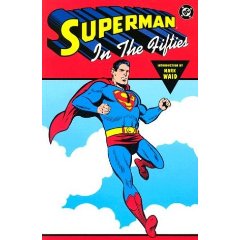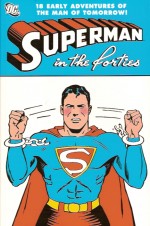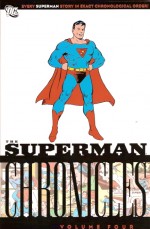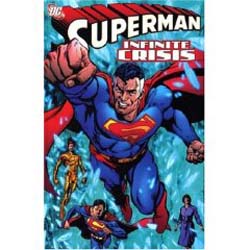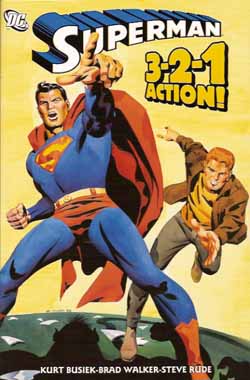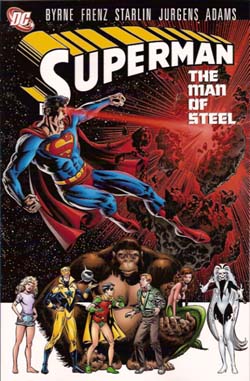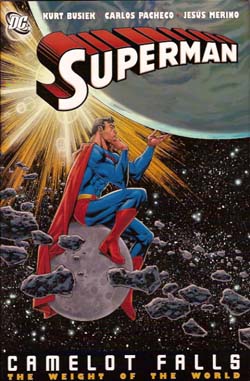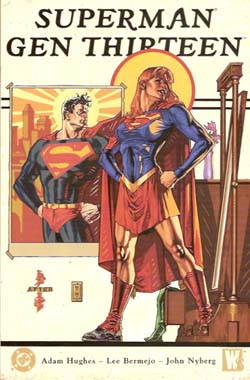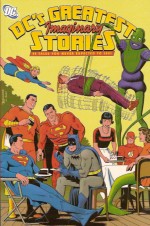
By various (DC Comics)
ISBN13: 978-1-4012-0534-8
Alan Moore’s famous epigram notwithstanding not all comics tales are “Imaginary Stories.” When DC Editor Mort Weisinger was expanding the Superman continuity and building the legend he knew that the each new tale was an event that added to a nigh-sacred canon: that what was written and drawn mattered to the readers. But as an ideas man he wasn’t going to let that aggregated “history” stifle a good idea, nor would he allow his eager yet sophisticated audience to endure clichéd deus ex machina cop-outs to mar the sheer enjoyment of a captivating concept.
The mantra known to every baby-boomer fan was “Not a Dream! Not a Hoax! Not a Robot!” boldly emblazoned on covers depicting scenes that couldn’t possibly be true… even if it was only a comic book.
Imaginary Stories were conceived as a way of exploring non-continuity plots and scenarios devised at a time when editors believed that entertainment trumped consistency and knew that every comic read was somebody’s first …or potentially last.
This jolly tome celebrates that period when whimsy and imagination were king and stretches the point by leading with a fanciful tale of the World’s Mightiest Mortal as ‘Captain Marvel and the Atomic War’ (Captain Marvel Adventures #66, October 1946) actually hoaxes the public with a demonstration of how the world could end in the new era of Nuclear Proliferation, courtesy of Otto Binder and CC Beck.
‘The Second Life of Batman’ (Batman #127 October 1959) by Bill Finger, Dick Sprang and Charles Paris doesn’t really fit the definition either, but the tale of a device that predicts how Bruce Wayne’s life would have run if his parents had not been killed is superb and engaging all the same.
‘Mr. and Mrs. Clark (Superman) Kent!’ by Binder and the brilliant Kurt Schaffenberger, was the first tale of an occasional series that began in Superman’s Girlfriend Lois Lane #9 (August 1960), depicting the laughter and tears that might result if the plucky news-hen secretly married the Man of Steel. From an era uncomfortably parochial and patronizing to women, there’s actually a lot of genuine heart and understanding in this tale and a minimum of snide sniping about “silly, empty-headed girls”.
Eventually the concepts became so bold that Imaginary Stories could command book length status. ‘Lex Luthor, Hero!’ (Superman #149, November 1961) by Jerry Siegel, Curt Swan and Sheldon Moldoff, recounts the mad scientist’s greatest master-plan and ultimate victory in a tale as powerful now as it ever was. In many ways this is what the whole concept was made for…
No prizes for guessing what ‘Jimmy Olsen Marries Supergirl!’ (Superman’s Pal Jimmy Olsen, #57, December 1961) is about, but the story is truly a charming delight, beautifully realized by Siegel, Swan and Stan Kaye.
‘The Origin of Flash’s Masked Identity!’ (The Flash# 128, May 1962) by John Broome, Carmine Infantino and Joe Giella, although highly entertaining, is more an enthusiastic day-dream than alternate reality, and, I suspect, added to bring variety to the mix – as is the intriguing ‘Batman’s New Secret Identity’ (Batman #151, November 1961, by Finger, Bob Kane and Paris).
‘The Amazing Story of Superman-Red and Superman-Blue!’ (Superman #162, July 1963) is possibly the most influential tale of this entire sub-genre. Written by Leo Dorfman, with art from Swan and George Klein, this startling utopian classic was so well-received that decades later it influenced and flavoured the post-Crisis on Infinite Earths Superman continuity for months.
The writer of ‘The Three Wives of Superman!’ is currently unknown to us but the ever-excellent Schaffenberger can at least be congratulated for this enchanting tragedy of missed chances that originally saw print in Superman’s Girlfriend Lois Lane #51, from August 1964.
‘The Fantastic Story of Superman’s Sons’ (Superman #166, November 1964) by Edmond Hamilton, Swan and Klein is a solid thriller built on a tragic premise (what if only one of Superman’s children inherited his powers?), and the book closes with the stirring and hard-hitting ‘Superman and Batman… Brothers!’, wherein orphaned Bruce Wayne is adopted by the Kents, but cannot escape a destiny of tragedy and darkness.
Written by Jim Shooter, with art from Swan and Klein, for World’s Finest Comics # 172 (December 1967) this moody thriller in many ways signalled the end of the care-free days and the beginning of a grittier, more cohesive DC universe for a less whimsical, fan-based audience.
This book is a glorious slice of fancy, augmented by an informative introduction by columnist Craig Shutt, and bolstered with mini-cover reproductions of many tales that didn’t make it into the collection, but I do have one minor quibble: No other type of tale was more dependent on an eye-catching cover, so why couldn’t those belonging to these collected classics have been included here, too?
© 1946, 1959-1964, 1967, 2005 DC Comics. All Rights Reserved

